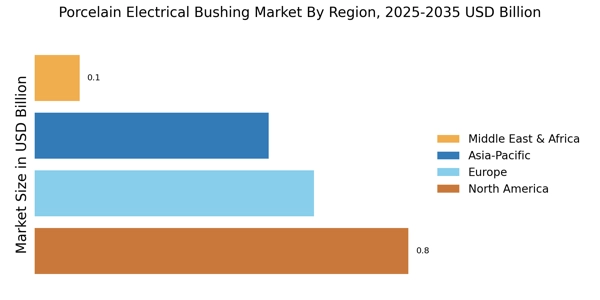Growing Focus on Energy Efficiency
The increasing emphasis on energy efficiency across various industries appears to be a significant driver for the Porcelain Electrical Bushing Market. As organizations strive to reduce energy consumption and minimize operational costs, the demand for high-performance electrical components, including porcelain bushings, is likely to rise. This trend is particularly evident in sectors such as manufacturing and utilities, where energy-efficient solutions are prioritized. Market analysis suggests that the push for energy efficiency will continue to shape the porcelain electrical bushing market, as companies seek to comply with regulatory standards and enhance their sustainability efforts.
Increasing Infrastructure Development
The ongoing expansion of infrastructure projects across various regions appears to be a key driver for the Porcelain Electrical Bushing Market. As countries invest in modernizing their electrical grids and transportation systems, the demand for reliable electrical components, including porcelain bushings, is likely to rise. For instance, the construction of new power plants and substations necessitates the use of durable and efficient electrical components. This trend is further supported by government initiatives aimed at enhancing energy efficiency and reliability in power distribution. The market for porcelain electrical bushings is projected to grow as these infrastructure developments continue, potentially leading to a compound annual growth rate of around 5% over the next few years.
Expansion of Renewable Energy Projects
The rapid expansion of renewable energy projects, such as wind and solar farms, seems to be a crucial factor influencing the Porcelain Electrical Bushing Market. As the world shifts towards sustainable energy sources, the need for reliable electrical components that can withstand harsh environmental conditions becomes paramount. Porcelain bushings are favored for their durability and insulation properties, making them ideal for use in renewable energy applications. Market forecasts indicate that the growth of renewable energy installations will drive demand for porcelain electrical bushings, potentially leading to a significant increase in market size as these projects proliferate.
Rising Demand for High Voltage Applications
The increasing need for high voltage applications in various sectors, such as energy and telecommunications, seems to significantly influence the Porcelain Electrical Bushing Market. As industries transition to higher voltage systems to improve efficiency and reduce transmission losses, the demand for high-quality porcelain bushings is expected to surge. These components are essential for ensuring safe and reliable electrical insulation in high voltage environments. Market data indicates that the high voltage segment is anticipated to account for a substantial share of the overall porcelain electrical bushing market, driven by the growing adoption of renewable energy sources and the expansion of smart grid technologies.
Technological Innovations in Electrical Components
Technological advancements in the manufacturing processes of electrical components are likely to propel the Porcelain Electrical Bushing Market forward. Innovations such as improved glazing techniques and enhanced material formulations contribute to the production of more durable and efficient porcelain bushings. These advancements not only enhance the performance of electrical systems but also reduce maintenance costs, making them more appealing to end-users. Furthermore, the integration of smart technologies into electrical components is expected to create new opportunities for the porcelain electrical bushing market, as manufacturers seek to meet the evolving needs of modern electrical infrastructure.


















Leave a Comment